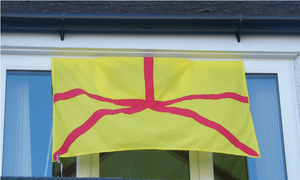Independence Day (Austenasia)
| Independence Day | |
|---|---|
 The first physical version of the Austenasian Star flying from the Imperial Residence on Independence Day 2011. | |
| Observed by | Empire of Austenasia |
| Type | National holiday |
| Significance | Anniversary of the Declaration of Independence of the Empire of Austenasia |
| Celebrations | The granting of honours by the Monarch, parades, speeches, and the coinciding of important events and declarations |
| Date | Third Saturday in September 2023: 16 September 2024: 21 September 2025: 20 September |
Independence Day is the most significant public holiday in the Empire of Austenasia, celebrated on the third Saturday in September. The holiday celebrates the anniversary of the Declaration of Independence of Austenasia from the United Kingdom on Saturday 20 September 2008.
Instead of being celebrated on 20 September, the holiday is celebrated on the third Saturday in the month. The 20th has sometimes seen an extension of the celebrations, with the public holiday being extended to that date in 2009 and 2013 when it was adjacent to Independence Day itself, and with intervening days also being declared public holidays in 2018 and 2023 in celebration of the tenth and fifteenth Independence Days respectively. Independence Day fell on the 20th in 2014, and will not do so again until 2025.
The holiday was established in October 2008 by Act 10 (Public Holidays), and first celebrated on 19 September the following year. Its first celebration saw the public holiday extended to Sunday 20th by Act 98, and its fifth celebration in 2013 saw both the preceding and succeeding days, Friday 20th and Sunday 22nd, also included in the public holiday by Edict VI Jon. I.
Independence Day is observed across the Empire and its embassies with celebratory parties, meals, and events. The constabulary of New South Scotland held a parade on the Empire's fifth anniversary in 2013, and military parades were held in New Richmond for Independence Days 2014 and 2015. Speeches are given or statements released observing the day, such as by the Emperor in 2013, 2014, 2016 and 2017 and by the Prime Minister in 2015, 2021 and 2023.
In 2010, and uninterruptedly since 2012, Independence Day (or, occasionally, the 20th) has seen the Monarch publish an honours list, granting a large number of knighthoods to various foreign and domestic recipients. This honours list sometimes includes peerages, as in 2013, 2015 and 2018, and even Imperial Titles, as in 2012, 2013 and 2014.
As the most momentous occasion in the Austenasian calendar, Independence Day (or sometimes the 20th itself) has often been used for significant announcements or events. Independence Day 2010 saw Emperor Esmond III visit Wrythe for his coronation; 2011 saw the first physical national flag of Austenasia unfurled over the Imperial Residence on Independence Day, and the Austenasian Constitution of 2011 come into force on the 20th; Independence Day 2014 saw local elections announced and the opening of the Imperial Museum; 2015 saw the coming into force of the First Constitutional Amendment; and 2021 saw the winning candidate of that year's general election announced and take office.
Independence Day 2018, celebrating the tenth anniversary of Austenasia, was the largest celebration to date. To mark the occasion a set of commemorative coins - the first (and to date only) minted by the Treasury - was released, and a party attended by Austenasian and foreign dignitaries was held at the Imperial Residence.
Independence Day 2023, the fifteenth anniversary, was also celebrated with special emphasis. Taeglan I Nihilus of Reyla and Calum I of the Grove were both hosted at the Imperial Residence by the Emperor, and a time capsule was buried in Wrythe Public Park.